Samuel the Sharpe
Regular

34th Cumberland Regiment of Foot


About the Regiment
The 34th Cumberland Regiment of Foot was raised on the 13th September 2012 and is currently headed by Captain Artimus. The regiment is small, but looking to grow and offers a variety of officer positions to be filled by those with the experience and capability. With six members in just a week of existence, the regiment is growing at a steady pace and with the help of eager, young recruits from the Taleworlds forums, we may be large enough to compete soon enough.

Who Are We Recruiting?
The 34th Cumberland Regiment will accept with open arms those who can make events that are generally scheduled around 7pm GMT. We have a number of members from the east coast of the USA who are able to attend, although we are primarily a European regiment and will be participating in European line battles using European times (GMT). We also ask that potential recruits be up to a standard when it comes to discipline and activeness. If you have trouble following orders or you aren't going to be able to show up to anything, I'm afraid the 34th isn't the place for you.

Sounds Good... What's In It For Me?
Despite being small, we are ready and able to participate in multiple infantry roles. We will be training in the eventuality we have to use rifles and act as skirmishers and also training in line infantry tactics, which is what we will try to use primarily. You have from here, the opportunity to fight in two different combat roles, with a group of like-minded individuals and friends from all over the world. We play an assortment of other games with each other, Napoleonic Wars is not the only game on the planet. Promotion is also a nice enticement, as the 34th is currently very short of officers. Experience is valued, and talent is recognised.

I'm Sold! How Do I Join This Hotness?
There are two ways to do this.
First Way: Simply private message me your Steam name for a chat, where some questions will be asked and some information given and if you meet the specifications, grab a musket and head into line, Private! You can alternatively add me on Steam yourself. My contact info is below.
First Way: Simply private message me your Steam name for a chat, where some questions will be asked and some information given and if you meet the specifications, grab a musket and head into line, Private! You can alternatively add me on Steam yourself. My contact info is below.
Second Way: Fill out this form and send to me the completed form over private message, or just here in the thread. I'll read every post to ensure we don't miss it. If the application is accepted, you will receive a friend request and a group request on Steam, and from there you can jump right in!
**Sign up form**
1. In-game name (Required)
2. Steam name (Required)
3. Age (Optional)
4. Timezone (Required)
5. Activeness (Required)
6. Previous experience (If any)
2. Steam name (Required)
3. Age (Optional)
4. Timezone (Required)
5. Activeness (Required)
6. Previous experience (If any)

Contact Information and Other Important Stuff
Steam Name
34th_Cpt_Artimus
Teamspeak Information
78.46.67.122
Come here to find me, I'll be in here most of the time. If I'm not around, speak to my Lieutenant, Shadera. Otherwise, just add me on Steam if nobody is available.
Come here to find me, I'll be in here most of the time. If I'm not around, speak to my Lieutenant, Shadera. Otherwise, just add me on Steam if nobody is available.
The Steam Page
The Steam page for the 34th Cumberland Regiment of Foot is where all of the important announcements are posted. Here is where I, and in the future, other officers, will post everything. From timetables, congratulations and even happy birthdays. Failure to check the Steam page at least once a day will result in a frowny face sticker! On a serious note, before joining please do take into consideration how important the Steam page is in organising events. Thank you.
Events and Dates
Monday
Tuesday
Wednesday
Thursday
Friday
Saturday
Sunday
Monday
No events, just have fun!
No events, just have fun!
Line battle, 7pm GMT
No events, just have fun!
Line Battle, Royal Scots, 7pm GMT
Line Battle, 7:30pm GMT
Training, 6pm GMT
Tags and Emblem
Rank Structure and Roster
Colonel -
Lieutenant Colonel -
Major -
Captain -
Lieutenant -
Ensign -
Regimental Sergeant Major -
Company Sergeant -
Sergeant - Corporal -
Private First Class -
Private -
Recruit -
Images
Bergice, the ugliest man in the regiment just about
 The 34th (What's left of them) stand around their slaughtered comrades. The Duke of Wellington also makes an appearance
The 34th (What's left of them) stand around their slaughtered comrades. The Duke of Wellington also makes an appearance
 Give the bastards what for!
Give the bastards what for!
 The Duke of Wellington poses for the camera.
The Duke of Wellington poses for the camera.

Videos
Regiment History
Raising of the Regiment - 1702
War of the Spanish Succession 1701 - 1715
1713 - 1719, Vigo
Gibraltar, 1727
Battle of Fontenoy, War of the Austrian Succession - 1745
Battle of Falkirk, Jacobite Uprising of 1745 - 1746
Battle of Culloden, Jacobite Uprising of 1745 - 1746
Official Numbering - 1751
Siege of Minorca, Seven Years War - 1756
1758 to 1762 and the Battle of Havannah - Seven Years War
The American Revolutionary War 1776-1786
The Cumberland Regiment - 1782
The West Indies, 1793 - 1797
South Africa, 1797 - 1803
Second Battalion - 1804
Peninsular War, 1808 - 1814 [Warning! Lots o' text!]
Mahratta and Pindari Wars 1812-19
Canada 1830-42
Corfu and the Ionian Islands 1845-48
Crimean War 1854-55
Indian Mutiny 1857-1858
Final Years, 1868 - 1881
All new recruits unless otherwise stated should have their tags as the following: "34th_Rec_*Name*"
The 34th CRF emblem is located on the last page, middle row and is the English flag. Red cross on a white background. In fact, if you look closely at this page, you will see the emblem scattered around.
The 34th CRF emblem is located on the last page, middle row and is the English flag. Red cross on a white background. In fact, if you look closely at this page, you will see the emblem scattered around.
Rules
1. PTS or, "Permission to speak" must be observed at all times during a line battle, or when an officer demands it of you during training for whatever reason.
2. No personal attacks on other members of the regiment. I don't want to have to break up fights between us. 34th should stick together.
3. Please follow line battle rules, it makes the rest of us look bad if you don't. If one of the rules is "Don't shoot out of line", please don't bloody shoot out of line.
4. Serious business over, have fun! The rules are for when we have serious events, otherwise anything really goes. I've never had a problem with cursing or otherwise, so it doesn't matter to me what you say in jest.
2. No personal attacks on other members of the regiment. I don't want to have to break up fights between us. 34th should stick together.
3. Please follow line battle rules, it makes the rest of us look bad if you don't. If one of the rules is "Don't shoot out of line", please don't bloody shoot out of line.
4. Serious business over, have fun! The rules are for when we have serious events, otherwise anything really goes. I've never had a problem with cursing or otherwise, so it doesn't matter to me what you say in jest.
Rank Structure and Roster
Colonel -
*Reserved*
*Reserved*
*Reserved*
Artimus
Shadera
*Reserved*
Xeridae
Perry
ToreD
Vampage
Lowdyn
Lowdyn
Azkar
Matty
Malignance
Joshua
Bergice
Jonny
Suvorov
Raxnoc
Tomitoch
Pekka
Whysoserious
Valhalla
Valdis
Matty
Malignance
Joshua
Bergice
Jonny
Suvorov
Raxnoc
Tomitoch
Pekka
Whysoserious
Valhalla
Valdis
Aquila
Racco
Racco
Images
Bergice, the ugliest man in the regiment just about
Videos
*Reserved*
Regiment History
Raising of the Regiment - 1702
The date of the first officers' commissions is 12th February 1702, one month before the death of William of Orange and the accession of Queen Anne. The officer charged with the raising of the regiment was Lord Robert Lucas who had served in what later became the 13th Foot. He had been Governor of the Tower of London since 1688 and his new regiment was given the responsibility of guard duties at the Tower and at Dover Castle. The men were recruited from East Anglia.
At first the regiment was stationed at Chelmsford with companies sent to man the Landguard Fort at Felixstowe, also Sheerness and Tilbury. In 1703, they were moved to Carlisle which was to be their depot for the next 250 years. This must have been an unpopular move for the men of East Anglia.

Drummer of the Cumberland Regiment, circa 1702
At first the regiment was stationed at Chelmsford with companies sent to man the Landguard Fort at Felixstowe, also Sheerness and Tilbury. In 1703, they were moved to Carlisle which was to be their depot for the next 250 years. This must have been an unpopular move for the men of East Anglia.

Drummer of the Cumberland Regiment, circa 1702
War of the Spanish Succession 1701 - 1715
Other regiments were also raised at this time for the war to support Archduke Charles's claim on the throne and prevent the alliance of France and Spain. The regiment was sent to the siege of Barcelona in an army under the command of Lord Peterborough. The grenadier company travelled for two days on mules to help storm the Fortress of Montjuic, on 1st April 1706, with heavy loss. The regiment helped the Catalans to garrison the captured city of Barcelona and fend off an attack by the French a year later. In 1707 they returned to the safety of England while the inhabitants of Barcelona suffered a terrible fate on being recaptured by the French in 1714.
Douai 1710
In April, the regiment joined Marlborough's army in northern France where they took part in the siege of Douai, a strongly fortified town. Hamilton's Regiment, as they were known then, was selected to be in the main storming party. It was a hard fought battle but they prevailed and took the town. But the casualty figures were high, 162 killed or wounded.
The siege of Bouchain was the last battle of Marlborough's career and a stunning success for him and his army. The Duke had already breached the lines of the French under Marshal Villars and decided, in August 1711, to besiege Bouchain despite the reservations of his staff. The main credit for this undertaking goes to an engineering officer called Colonel Armstrong who organized entrenchments and a 24-gun battery constructed in one night. The regiment's grenadier company were part of a 400 strong force which had to wade through water up to their necks to surprise the enemy and seize the Cow Path, a line of communication between Villar's army and the town. Once the attack trenches were open and the breaching batteries were in position, a remorseless bombardment began to reduce Bouchain's defences. After several days the infantry stormed in, on 4th September, and brought about the town's surrender.

Officer uniform of the Cumberland Regiment during the War of the Spanish Succession
Douai 1710
In April, the regiment joined Marlborough's army in northern France where they took part in the siege of Douai, a strongly fortified town. Hamilton's Regiment, as they were known then, was selected to be in the main storming party. It was a hard fought battle but they prevailed and took the town. But the casualty figures were high, 162 killed or wounded.
The siege of Bouchain was the last battle of Marlborough's career and a stunning success for him and his army. The Duke had already breached the lines of the French under Marshal Villars and decided, in August 1711, to besiege Bouchain despite the reservations of his staff. The main credit for this undertaking goes to an engineering officer called Colonel Armstrong who organized entrenchments and a 24-gun battery constructed in one night. The regiment's grenadier company were part of a 400 strong force which had to wade through water up to their necks to surprise the enemy and seize the Cow Path, a line of communication between Villar's army and the town. Once the attack trenches were open and the breaching batteries were in position, a remorseless bombardment began to reduce Bouchain's defences. After several days the infantry stormed in, on 4th September, and brought about the town's surrender.

Officer uniform of the Cumberland Regiment during the War of the Spanish Succession
1713 - 1719, Vigo
Following the Peace of Utrecht in 1713 the army was reduced and the 34th was actually disbanded, but re-raised the following year, retaining it's place in the Line. In 1717 the regiment was garrisoned in Ireland but sent on the campaign to northern Spain in 1719. The Spanish were in support of the Jacobite rebellion and planned to invade Scotland. A British force under Lord Cobham was sent to capture Corunna but switched to the port of Vigo which was captured on 1st October.
Gibraltar, 1727
Gibraltar had been captured from Spain in 1704 but in 1726 the Spaniards laid siege to the Rock with a large force. Gibraltar was defended by 1,800 British troops (the 5th,13th, 20th and 30th Foot) so reinforcements were sent out which included the 34th Foot. The regiment was commanded by Colonel Robert Hayes and consisted of 32 officers and 388 men. The reinforcements numbered 3,680 and arrived at different times between 3rd Feb and 23rd April 1727. Hayes regiment came on 26th March, on the Torbay, along with Middleton's (25th Foot). After a 5 month siege the Spaniards gave up, with the loss of 2,000 men to the British 105. The 34th sustained casualties: 2 killed, 16 wounded, 2 died of wounds, 8 died of sickness and 2 deserted. The regiment went to Jamaica soon afterwards to spend some years there, returning to England for a period of marine service on the Channel Fleet.

Siege of Gibraltar

Siege of Gibraltar
Battle of Fontenoy, War of the Austrian Succession - 1745
The regiment went to Flanders in 1742 to reinforce the army after Dettingen. By 1745 they were at Fontenoy as part of the rearguard. The British centre found that in the attack they were not supported by their allies on the flanks. They were in danger of being surrounded but the French were foiled by the gallant action of the troops in the rear. The 34th played a significant part in this action and were granted the honour of a laurel wreath hung on their Colours. These Colours are to be found hanging in Carlisle Cathedral today. The wreath formed part of the regimental badge for the rest of the unit's history.

The battle of Fontenoy

The battle of Fontenoy
Battle of Falkirk, Jacobite Uprising of 1745 - 1746
The regiment, called Cholmondley's, took part in this confused battle west of Edinburgh. On the 17th January 1746 the highlanders and redcoats fought in driving rain that dampened the powder of most muskets. Brigadier-General James Cholmondley, Colonel of the regiment, proved to be the hero of the action when he rallied some regiments, including the King's Own, to make a stand against charging rebels. The 34th were not part of this but they were involved in the battle to the extent that their commanding officer, Lt-Col Maurice Powell, was killed. Both sides claimed victory but the Jacobites withdrew north towards Inverness.
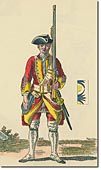
Uniform of a Cumberland Regiment Private circa 1742

Uniform of a Cumberland Regiment Private circa 1742
Battle of Culloden, Jacobite Uprising of 1745 - 1746
The regiment were hurried back to Britain when the second Jacobite Rebellion broke out. They fought at Falkirk and then went on to Culloden where they were placed in the centre of the front line. Fortunately for them, the brunt of the rebel attack was on the left of the line, against the 4th and 37th Foot. Their casualties were light, one man killed and 2 wounded out of a total of 460 all ranks.

Bayonet charge at the battle of Culloden

Bayonet charge at the battle of Culloden
Official Numbering - 1751
In 1751, the regiment was given a number, and was henceforth known as the "34th Regiment of Foot".
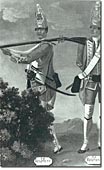
Uniform of the Grenadier Company for the 34th Regiment, circa 1751

Uniform of the Grenadier Company for the 34th Regiment, circa 1751
Siege of Minorca, Seven Years War - 1756
The regiment were sent to help garrison Minorca in 1752 with three other units, one of which was the 4th Foot. The main action took place in April 1756 when the French besieged the island with eventual success.

Sacking of fort St. Phillip

Sacking of fort St. Phillip
1758 to 1762 and the Battle of Havannah - Seven Years War
They served at Cherbourg in 1758 and were then sent to the West Indies in 1762 for the siege of Havannah. They fought bravely and stormed the defences successfully, thus gaining themselves their first battle honour. After this they did garrison duty in Florida. They were at one point stationed at Mobile where they nearly starved due to the interruption of supplies from Jamaica.

The British fleet closing in on Havannah

The British fleet closing in on Havannah
The American Revolutionary War 1776-1786
The 34th were in Canada during the War of American Independence. They arrived in Quebec in May 1776 and fought in the backwoods. The flank companies were detached and served with General Burgoyne until the surrender at Saratoga in October 1777. They were made prisoners of war in contravention of the terms of surrender. The regiment finally returned to the UK in 1786.

Surrender of British general, Burgoyne

Surrender of British general, Burgoyne
The Cumberland Regiment - 1782
Up until 1782 the infantry regiments had been given numbers only. But the government decided that it was easier to recruit if the regiments were attached to an area by name. Although the 34th had originated in East Anglia, they had been in Carlisle for the last eighty years and were named 34th or the Cumberland Regiment of Foot. This was to be their title for the next 99 years.

Private soldier of the 34th Regiment circa American Revolution

Private soldier of the 34th Regiment circa American Revolution
The West Indies, 1793 - 1797
They served in St Lucia and Grenada during the French Revolutionary War. In St Vincent they helped to suppress the Black Caribs who were finally deported in 1797. The British established the island as a British colony after a century of rivalry with France.
South Africa, 1797 - 1803
In 1797 the 34th along with the 22nd and 65th were ordered to recruit boys between the ages of 12 and 15 from the poorhouses. The rendezvous for these boys was Lincoln. The three regiments then went to Capetown in South Africa where the Third Kaffir War was in progress. The Boy Regiments, as they were called, arrived in May 1800 and disembarked in a dreadful state, unable to carry their muskets. The 81st and 91st regiments were already there, with some of the 8th Light Dragoons. Soldiers drawn from all these units were selected for a mounted infantry company. They were involved in patrols and constant skirmishes with the Xhosas and Hottentots. In accordance with the Treaty of Amiens of 1803, the Cape was handed back to the Dutch and the troops withdrawn. The Dutch concluded peace with the Xhosas. The British had lost 27 killed and 10 other deaths.
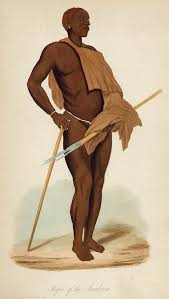
Xhosa Warrior, the kind fighting against the 34th Regiment
Xhosa Warrior, the kind fighting against the 34th Regiment
Second Battalion - 1804
Many regiments were told to raise a second battalion and the 34th was one of them. Volunteers from various militia regiments were formed into the 2nd Battalion by 25th April 1804. It was this battalion that fought in the Peninsular War and gained nine of the 34th's twelve battle honours.
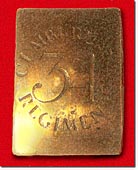
Belt badge of a 34th Regiment private circa 1806

Belt badge of a 34th Regiment private circa 1806
Peninsular War, 1808 - 1814 [Warning! Lots o' text!]
Bussaco 1810
The early years of the battalion were spent in ineffective and unnecessary enforced travelling. But in 1809, with 1,000 men they embarked for the Peninsula. They were placed in Rowland Hill's 2nd Division and brigaded under Catlin Crawford. By the following year, Wellington was retreating before Massena's army and found a strong defensive position on Bussaco ridge to stand and fight. The 34th were on the right of the line when the battle began at dawn on the 27th September 1810. Most of the action took place in the centre and left of the line and the 34th along with other units remained mostly unscathed.
Albuhera 1811
The Battle of Albuhera was one of the bloodiest in the history of the British Army, and the 34th suffered great loss on this day, 16th May 1811. They were still in the 2nd Division, this time under Stewart, and in Abercrombie's brigade. The allied commander, Beresford, whilst besieging Badajoz was alerted to the advance of Soult with a force of 25,000 to relieve the city. Taking his force of British, Spanish and Portuguese, they were preparing for battle around the town of Albuhera when Soult arrived and appeared to threaten the Allied centre. But more French troops came in from the south and Stewart's division was sent to support the Spanish brigades. A hail storm dampened their powder and a murderous cavalry charge of Vistula Lancers tore into Colbourne's brigade, one third of Stewart's Division. The four battalions that made up the brigade were practically wiped out. The other two brigades, numbering 3,700 drew themselves up to face 7,800 French infantry to exchange volleys. They were about 20 yards apart and fired at each other for nearly an hour. Beresford desperately tried to get some Spanish infantry to help the dwindling battalions but in the end the 4th Division came to their aid and a spirited charge by the 7th and 23rd Foot drove the French back. Soult retired away from Badajoz but the British were in no fit state to pursue them. The British lost more than 4,000 men, the Spanish 1,300 and the Portuguese nearly 400. The French lost 7,000.
Arroyo dos Molinos 1811
Towards the close of the fighting season, Rowland Hill pulled off a bold move against General Girard at Arroyo dos Molinos. Today the place is called Arroyomolinos which is near Alcuescar, 70 km northeast of Badajoz in the Spanish region of Extremadura. The 34th were in Wilson's 3rd Brigade of the 2nd Division, commanded again by Hill. They march in terrible weather and surrounded the French in Arroyo during the night of the 27th October. At dawn on the 28th, the weather was still bad so the French sentries were not as attentive as they should have been. The Allied attack was a complete surprise and a success except for the loss of 100 men. The French lost 750 and the number of prisoners taken was 1,300. By coincidence the 34th fought against the 34e Regiment d'Infanterie de Ligne. They accounted for most of the prisoners. The French lost all their baggage and loot and the 34th seized the drums and drum-major's mace from their opposite number. These have been treasured trophies of the regiment ever since.
Vittoria 1813
The 34th were not in the thick of this battle. They were in O'Callaghan's brigade in the southern sector. The battle began at 8.30 on 21st June and was a total victory for the British, Spanish and Portuguese army. Unfortunately the defeated French were not pursued to the border because a huge haul of booty was discovered in a wagon park and this was too tempting for the allies.
Pyrenees 1813
Wellington needed to wait and see how things developed in northeast Europe before attempting an invasion of France. He decided to establish a line of defence in the Pyrenees between San Sebastian and Pamplona. Whilst those two cities were being besieged, the French launched an offensive to push the allies out of the mountains and relieve the French garrisons. Soult was now in command and there were only 3 ways he could march through the mountains; the Great Road from Bayonne to San Sebastian and the two passes at Maya and Roncesvalles. He chose the latter two, advancing on 25th July 1813. The 34th were in Stewart's Division at Maya which came up against D'Erlon's Corp. The outposts were swept back and reinforcements were sent in piecemeal which was a bad mistake. Out of 6,000 British troops, 1,500 were killed. The pass was now in French hands and the troops withdrew towards Pamplona. Things did not go so well at Roncesvalles either, and Wellington was riding around at great speed to organise a confrontation at Sorauren. The morale of the retreating divisions improved markedly under Wellington's command by the time battle commenced on 28th July. There was fierce fighting all day until late afternoon, resulting in the loss of 1,360 British, 1,100 Portuguese and 200 Spanish. Soult's progress had been blocked but it was not until 2nd August that he was driven back over the border.
Bidassoa 1813
Wellington's crossing of the Bidassoa was well planned. Near the mouth of the river where it was 1,000 yards wide, it was discovered that at certain tides the water was low enough to wade across. One of these low tides was set to occur on the 7th October. The sappers were ordered to build an earth wall near the west bank of the river to hide troops before they crossed to the east bank. This crossing was made successfully and the ensuing battle resulted in low casualties. The crossings higher up the river met with stiffer resistance but the 34th were not involved in hard fighting on the right of the Allied line.
Nivelle 1813
Marshal Soult organised defences along the Nivelle river but his force of 60,000 was stretched too thin, all the way to Roncesvalles. After Pamplona had fallen at the end of October, Wellington felt confident enough to advance to contact. The French had fortified hills along the east bank and on 10th Nov the Allies attacked. Some of these positions were tougher to take than others and some regiments took heavy losses. Wellington outnumbered Soult, having 80,000 British, Portuguese and Spanish troops. The 2nd (including the 34th) and 6th Divisions were on the right of the line under Rowland Hill. Again, they were spared too much loss, although the army as a whole suffered 2,450 casualties against the French loss of 4,350.
Nive 1813
The 2nd Battalion, 34th, as part of the 2nd Division were under Hill's command at this battle. The battle began on the 9th Dec although it was not until the 12th that they found themselves involved in heavy fighting on the east bank of the Nive at St Pierre. Hill's Divisions (2nd, 3rd and 6th) numbering around 14,000 had been cut off from the rest of the army after their pontoon bridge at Usteritz was washed away in the swollen river. Soult concentrated his attack on them and there was difficult situation for several hours before Wellington could bring reinforcements and drive the French off. The mild-mannered Hill had been under such stress that he was heard to swear, for only the second time in the whole war. When Wellington heard this he said," If Hill has begun to swear, they must all mind what they are about."
Orthez 1814
Soult pulled back from Bayonne, leaving a strong garrison there. He set up defences on a ridge the other side of the river Gave de Pau. The British and Portuguese crossed the Adour on the 24th February and when the battle began on the 27th Beresford's Divisions were already on Soult's side of the Gave de Pau. Hill's 2nd and Portuguese Divisions on the right were to cross the river above Orthez and turn the left flank of the French position. The attacks proved too much for the French who took heavy casualties, and they retreated.
Toulouse 1814
The battle of Toulouse was unnecessary as Napoleon had already abdicated. The news did not reach Soult in the city of Toulouse until the evening of the 10th April while the siege was in progress. The Allied plan was to secure the heights to the east while Hill's Divisions, including the 34th were to make a diversionary attack on the city. Soult decided to surrender, but only after 600 Allied troops had been killed and 4,000 wounded.
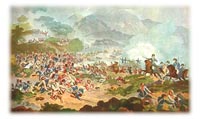
Battle in the Pyrenees
The early years of the battalion were spent in ineffective and unnecessary enforced travelling. But in 1809, with 1,000 men they embarked for the Peninsula. They were placed in Rowland Hill's 2nd Division and brigaded under Catlin Crawford. By the following year, Wellington was retreating before Massena's army and found a strong defensive position on Bussaco ridge to stand and fight. The 34th were on the right of the line when the battle began at dawn on the 27th September 1810. Most of the action took place in the centre and left of the line and the 34th along with other units remained mostly unscathed.
Albuhera 1811
The Battle of Albuhera was one of the bloodiest in the history of the British Army, and the 34th suffered great loss on this day, 16th May 1811. They were still in the 2nd Division, this time under Stewart, and in Abercrombie's brigade. The allied commander, Beresford, whilst besieging Badajoz was alerted to the advance of Soult with a force of 25,000 to relieve the city. Taking his force of British, Spanish and Portuguese, they were preparing for battle around the town of Albuhera when Soult arrived and appeared to threaten the Allied centre. But more French troops came in from the south and Stewart's division was sent to support the Spanish brigades. A hail storm dampened their powder and a murderous cavalry charge of Vistula Lancers tore into Colbourne's brigade, one third of Stewart's Division. The four battalions that made up the brigade were practically wiped out. The other two brigades, numbering 3,700 drew themselves up to face 7,800 French infantry to exchange volleys. They were about 20 yards apart and fired at each other for nearly an hour. Beresford desperately tried to get some Spanish infantry to help the dwindling battalions but in the end the 4th Division came to their aid and a spirited charge by the 7th and 23rd Foot drove the French back. Soult retired away from Badajoz but the British were in no fit state to pursue them. The British lost more than 4,000 men, the Spanish 1,300 and the Portuguese nearly 400. The French lost 7,000.
Arroyo dos Molinos 1811
Towards the close of the fighting season, Rowland Hill pulled off a bold move against General Girard at Arroyo dos Molinos. Today the place is called Arroyomolinos which is near Alcuescar, 70 km northeast of Badajoz in the Spanish region of Extremadura. The 34th were in Wilson's 3rd Brigade of the 2nd Division, commanded again by Hill. They march in terrible weather and surrounded the French in Arroyo during the night of the 27th October. At dawn on the 28th, the weather was still bad so the French sentries were not as attentive as they should have been. The Allied attack was a complete surprise and a success except for the loss of 100 men. The French lost 750 and the number of prisoners taken was 1,300. By coincidence the 34th fought against the 34e Regiment d'Infanterie de Ligne. They accounted for most of the prisoners. The French lost all their baggage and loot and the 34th seized the drums and drum-major's mace from their opposite number. These have been treasured trophies of the regiment ever since.
Vittoria 1813
The 34th were not in the thick of this battle. They were in O'Callaghan's brigade in the southern sector. The battle began at 8.30 on 21st June and was a total victory for the British, Spanish and Portuguese army. Unfortunately the defeated French were not pursued to the border because a huge haul of booty was discovered in a wagon park and this was too tempting for the allies.
Pyrenees 1813
Wellington needed to wait and see how things developed in northeast Europe before attempting an invasion of France. He decided to establish a line of defence in the Pyrenees between San Sebastian and Pamplona. Whilst those two cities were being besieged, the French launched an offensive to push the allies out of the mountains and relieve the French garrisons. Soult was now in command and there were only 3 ways he could march through the mountains; the Great Road from Bayonne to San Sebastian and the two passes at Maya and Roncesvalles. He chose the latter two, advancing on 25th July 1813. The 34th were in Stewart's Division at Maya which came up against D'Erlon's Corp. The outposts were swept back and reinforcements were sent in piecemeal which was a bad mistake. Out of 6,000 British troops, 1,500 were killed. The pass was now in French hands and the troops withdrew towards Pamplona. Things did not go so well at Roncesvalles either, and Wellington was riding around at great speed to organise a confrontation at Sorauren. The morale of the retreating divisions improved markedly under Wellington's command by the time battle commenced on 28th July. There was fierce fighting all day until late afternoon, resulting in the loss of 1,360 British, 1,100 Portuguese and 200 Spanish. Soult's progress had been blocked but it was not until 2nd August that he was driven back over the border.
Bidassoa 1813
Wellington's crossing of the Bidassoa was well planned. Near the mouth of the river where it was 1,000 yards wide, it was discovered that at certain tides the water was low enough to wade across. One of these low tides was set to occur on the 7th October. The sappers were ordered to build an earth wall near the west bank of the river to hide troops before they crossed to the east bank. This crossing was made successfully and the ensuing battle resulted in low casualties. The crossings higher up the river met with stiffer resistance but the 34th were not involved in hard fighting on the right of the Allied line.
Nivelle 1813
Marshal Soult organised defences along the Nivelle river but his force of 60,000 was stretched too thin, all the way to Roncesvalles. After Pamplona had fallen at the end of October, Wellington felt confident enough to advance to contact. The French had fortified hills along the east bank and on 10th Nov the Allies attacked. Some of these positions were tougher to take than others and some regiments took heavy losses. Wellington outnumbered Soult, having 80,000 British, Portuguese and Spanish troops. The 2nd (including the 34th) and 6th Divisions were on the right of the line under Rowland Hill. Again, they were spared too much loss, although the army as a whole suffered 2,450 casualties against the French loss of 4,350.
Nive 1813
The 2nd Battalion, 34th, as part of the 2nd Division were under Hill's command at this battle. The battle began on the 9th Dec although it was not until the 12th that they found themselves involved in heavy fighting on the east bank of the Nive at St Pierre. Hill's Divisions (2nd, 3rd and 6th) numbering around 14,000 had been cut off from the rest of the army after their pontoon bridge at Usteritz was washed away in the swollen river. Soult concentrated his attack on them and there was difficult situation for several hours before Wellington could bring reinforcements and drive the French off. The mild-mannered Hill had been under such stress that he was heard to swear, for only the second time in the whole war. When Wellington heard this he said," If Hill has begun to swear, they must all mind what they are about."
Orthez 1814
Soult pulled back from Bayonne, leaving a strong garrison there. He set up defences on a ridge the other side of the river Gave de Pau. The British and Portuguese crossed the Adour on the 24th February and when the battle began on the 27th Beresford's Divisions were already on Soult's side of the Gave de Pau. Hill's 2nd and Portuguese Divisions on the right were to cross the river above Orthez and turn the left flank of the French position. The attacks proved too much for the French who took heavy casualties, and they retreated.
Toulouse 1814
The battle of Toulouse was unnecessary as Napoleon had already abdicated. The news did not reach Soult in the city of Toulouse until the evening of the 10th April while the siege was in progress. The Allied plan was to secure the heights to the east while Hill's Divisions, including the 34th were to make a diversionary attack on the city. Soult decided to surrender, but only after 600 Allied troops had been killed and 4,000 wounded.

Battle in the Pyrenees
Mahratta and Pindari Wars 1812-19
Whilst the 2nd Battalion was racking up battle honours for the regiment in the Peninsula, the 1st Battalion was in India. After leaving South Africa in 1802 they went to Madras for garrison duty. There was little for them to do at first but in 1814 they were sent to fight the Mahrattas. The rajahs and feudal chiefs of central India relied on the Mahratta horsemen, and their plundering accomplices the Pindaris, for their wealth. They conducted a reign of terror over a large area for many years. The British mostly under Warren Hastings, tried to curb their looting activities in a series of wars. The first was in 1775, the second was in 1803 which the 34th were not involved in. In 1812 the flank companies were called upon in the Pindari Wars and in 1814 the third Mahratta war. They were part of a column led by Brigader Pritzler from Bombay. They distinguished themselves at the storming of Sholapore and at the siege and capture of Copal Droog. The Pindaris and Mahrattas were finally defeated in 1817 and 1819 respectively. The battalion companies remained at Madras during this time and then to Wallajabad. The whole regiment was due to return to England in 1823 but were given the option to stay in India to serve in other units. A majority of 537 opted to stay and 116 sailed home.
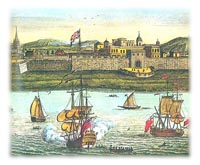
Fort St. George, Madras

Fort St. George, Madras
Canada 1830-42
The first and second battalions never met each other because the second were disbanded in 1817 and the remnants of the first battalion returned in 1823. The following year they went to Ireland for several years before being posted to Canada. During the disturbances in Lower Canada in 1838 they were one of the regiments sent on horse sleighs from New Brunswick to Canada in the depth of winter. From 1838 to 1841 they were posted on the US frontier at Amherstburg on the Detroit River.

Richard Airey, the Commanding Officer of the 34th in 1838 - 1847

Richard Airey, the Commanding Officer of the 34th in 1838 - 1847
Corfu and the Ionian Islands 1845-48
The regiment, along with other units, was sent to Corfu in 1845. The Ionian Islands had passed from Venetian, to French and then, in 1815 to British control as a Protectorate. The Greeks on the mainland fought their war of independence against the Ottoman empire from 1821 to 1830, in which year they achieved their aim. From then on the Ionians agitated for enosis with Greece and the British Government had to send troops there to keep the peace. They stayed there up to 1848 when they were posted to the West Indies until 1853.

Ensign in the 34th Cumberland Regiment, circa 1856

Ensign in the 34th Cumberland Regiment, circa 1856
Crimean War 1854-55
Sevastopol
The 34th joined the army in the Crimea later than most, landing on the 9th December 1854. They had to suffer terrible hardship during the winter months around Sevastopol and lost many of their number as a result of ill health, and in battle. In the Russian Sortie of 22nd March 1855 they played a prominent part. Lieutenant-Colonel Richard Denis Kelly narrowly escaped death and was taken prisoner in this action. He was later to become the CO of the regiment in the Indian Mutiny. Also in this action, Lieut William Jordan was killed.
18th June 1855
The best known action in the siege of Sevastopol happened on the 18th June, the anniversary of the Battle of Waterloo. Two main Russian defences were to be attacked on this day. The Malakoff and the Redan. The French were allocated the Malakoff and the British had to storm up to the Redan. The regiments selected for the attack were the 7th, 33rd, 88th, 34th, 57th and the Rifle Brigade, 800 in all, led by Sir John Campbell. The Russians had positioned extra guns in the night, loaded with grapeshot, so when the attack began in the early hours of the 18th the fire-storm directed at the advancing men was horrific. The CO of the 57th was killed and Campbell put himself at their front, leading the attack with Colonel Yea of the 7th. They were well in front of the body of men and both killed. The number of officer casualties was high which demoralised the men and they pulled back from the impenetrable Russian volleys having suffered the loss of nearly half their number. Only two officers of the 34th escaped injury or death. Officers of the regiment killed or died later from this attack were:
Ensign Robert John Browne Clayton, aged 20 and an only son form Aldington Lancs, died from wounds on 12th July.
Lieut H D Alt, killed
Capt Francis R Hurt, killed
Capt John Robinson, aged 29, killed.
Capt John Shiffner, killed
Private Charles Byrne was wounded in the throat. The bullet was removed in Netley Hospital and shown to Queen Victoria who was visiting the wounded there. She ordered it to be set in in a silver cross and presented to him. He also received the DCM when that decoration was instituted in 1862.
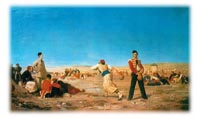
Men of the 34th Regiment playing skittles against French Zouaves
The 34th joined the army in the Crimea later than most, landing on the 9th December 1854. They had to suffer terrible hardship during the winter months around Sevastopol and lost many of their number as a result of ill health, and in battle. In the Russian Sortie of 22nd March 1855 they played a prominent part. Lieutenant-Colonel Richard Denis Kelly narrowly escaped death and was taken prisoner in this action. He was later to become the CO of the regiment in the Indian Mutiny. Also in this action, Lieut William Jordan was killed.
18th June 1855
The best known action in the siege of Sevastopol happened on the 18th June, the anniversary of the Battle of Waterloo. Two main Russian defences were to be attacked on this day. The Malakoff and the Redan. The French were allocated the Malakoff and the British had to storm up to the Redan. The regiments selected for the attack were the 7th, 33rd, 88th, 34th, 57th and the Rifle Brigade, 800 in all, led by Sir John Campbell. The Russians had positioned extra guns in the night, loaded with grapeshot, so when the attack began in the early hours of the 18th the fire-storm directed at the advancing men was horrific. The CO of the 57th was killed and Campbell put himself at their front, leading the attack with Colonel Yea of the 7th. They were well in front of the body of men and both killed. The number of officer casualties was high which demoralised the men and they pulled back from the impenetrable Russian volleys having suffered the loss of nearly half their number. Only two officers of the 34th escaped injury or death. Officers of the regiment killed or died later from this attack were:
Ensign Robert John Browne Clayton, aged 20 and an only son form Aldington Lancs, died from wounds on 12th July.
Lieut H D Alt, killed
Capt Francis R Hurt, killed
Capt John Robinson, aged 29, killed.
Capt John Shiffner, killed
Private Charles Byrne was wounded in the throat. The bullet was removed in Netley Hospital and shown to Queen Victoria who was visiting the wounded there. She ordered it to be set in in a silver cross and presented to him. He also received the DCM when that decoration was instituted in 1862.

Men of the 34th Regiment playing skittles against French Zouaves
Indian Mutiny 1857-1858
The regiment returned to England after the Crimean War but were almost immediately sent away again when news reached Britain that mutiny had broken out in India. They were at Cawnpore and then formed part of Sir Colin Campbell's column to relieve Lucknow 50 miles to the northeast across the Ganges. The relief was achieved finally in the spring of 1858. After that they were at the relief of Azimghur, and campaigned in Oudh and the Trans-Gogra.
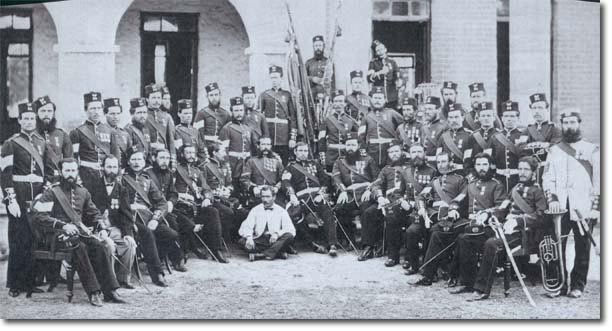
Officers from the 34th Regiment posing for a photograph

Officers from the 34th Regiment posing for a photograph
Final Years, 1868 - 1881
The 34th left India in 1868 and returned to England. They sailed out again in 1875, returning to Bengal and proceeding to Burma when the Third Burma War started. They stayed until 1890. Throughout this period they were linked to the 55th Westmorland Regiment, as from 1873, sharing the depot at Carlisle Castle. In 1881 the two regiments became the 1st and 2nd Battalions of The Border Regiment.
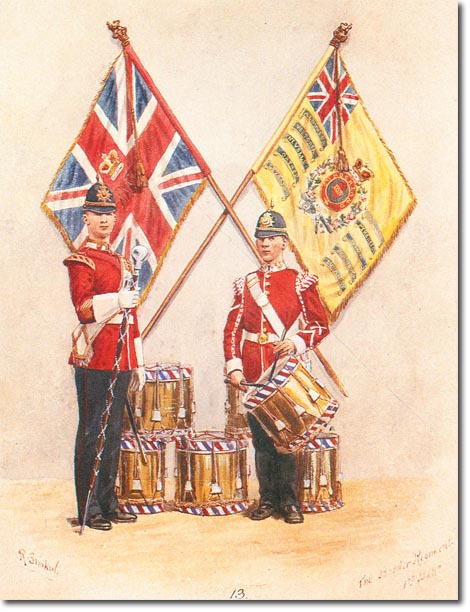
Colours of the First Battalion of the 34th Cumberland Regiment of Foot with uniformed Colour Guard, circa 1871

Colours of the First Battalion of the 34th Cumberland Regiment of Foot with uniformed Colour Guard, circa 1871












